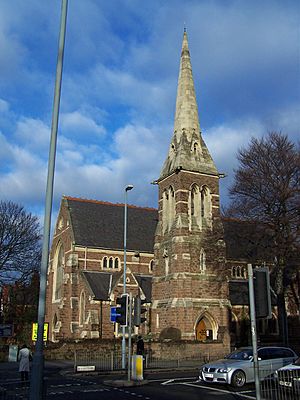Holy Trinity Church, Birchfield facts for kids
Quick facts for kids Holy Trinity |
|
|---|---|
 |
|
| 52°30′30.21″N 1°54′8.18″W / 52.5083917°N 1.9022722°W | |
| Location | Birchfield, Birmingham |
| Country | England |
| Denomination | Church of England |
| History | |
| Dedication | Holy Trinity |
| Architecture | |
| Heritage designation | Grade II* listed |
| Architect(s) | J. A. Chatwin |
| Style | Victorian Gothic |
| Completed | 1864 |
| Specifications | |
| Length | 117 feet (36 m) |
| Width | 48.5 feet (14.8 m) |
| Materials | Hollington sandstone |
| Administration | |
| Parish | Birchfield |
| Deanery | Handsworth |
| Archdeaconry | Birmingham |
| Diocese | Anglican Diocese of Birmingham |
Holy Trinity Church is a special old church located in Birchfield, Birmingham, England. It is a parish church that belongs to the Church of England. This church is a 'Grade II* listed' building. This means it is very important and protected because of its history and beautiful design.
In 2018, the church building was put on a list called the Heritage at Risk Register. This happened because it was in poor condition. Luckily, repairs were made, and the church is now safe. It has been removed from that list.
Contents
History of Holy Trinity Church
Building the Church
The first stone for Holy Trinity Church was laid on May 26, 1863. A famous architect named J. A. Chatwin designed the church. Builders Briggs & Son constructed it using red sandstone. This stone had a rough, natural look. White limestone was used for decorative bands and details.
The church was officially opened on May 17, 1864. John Lonsdale, who was the Bishop of Lichfield at the time, led the special ceremony. The building was made to hold 612 people. It is about 117 feet long and 48.5 feet wide.
Beautiful Stained Glass
Holy Trinity Church has many beautiful stained glass windows. These windows were made by some of the best Victorian artists. Companies like Clayton and Bell, Heaton, Butler and Bayne, John Hardman, and Alexander Gibbs created them. Each window tells a story or shows a scene.
Church Community and Changes
In 1865, Holy Trinity Church became its own parish. A parish is like a local church area. Before this, it was part of St Mary's Church, Handsworth. Later, in 1926, a part of Holy Trinity's parish was used to create a new parish for All Souls' Church, Witton.
Recent Repairs and Support
In 2010, Eve Pitts became the vicar of Holy Trinity Church. A vicar is a type of priest who leads the church. She helped get a grant from the National Lottery Heritage Fund. This money was used to help fix up the church building.
As mentioned, in 2018, the church was placed on Historic England's Heritage at Risk Register. This was mainly because its roof needed a lot of work. Thanks to the grant and hard work, the repairs were completed. The church is now in good condition and is no longer on the 'at risk' list.
Church Organ
Holy Trinity Church has an organ that was built in 1866. It was made by a company called Banfield. You can find details about this organ on the National Pipe Organ Register.

